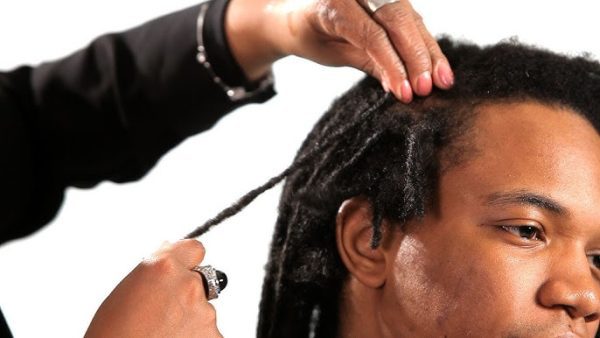
Dreadlocks are a beautiful hairstyle but can be a source of frustration for people experiencing hair loss. Certain circumstances can contribute to thinning hair dreadlocks, even though hair loss is a natural part of the development cycle. Let us explore the factors that led to this concern as well as the possible answers to it.
Understanding Thinning Hair in Dreadlocks
Thinning hair in dreadlocks is a noticeable decrease in locs’ density and fullness, often affecting the visible scalp at the crown or hairline. Locs may feel thinner and lighter, and loose hairs become more common, leading to increased breakage and shedding of entire locs.
Some key signs that your dreadlocks might be thinning include various visual signs, such as increased scalp visibility, reduced loc thickness, increased breakage and shedding, scalp tenderness, inflammation, and excessive itching. Scalp visibility is a major indicator, especially at the crown or hairline. Individual locs may feel thinner and looser than usual, and entire locs may break off more easily. Scalp tenderness may be experienced, especially around loc roots, and inflammation may be caused by stress on hair follicles. Excessive itching on the scalp may indicate underlying hair loss issues.
Causes of Thinning Dreadlocks
Some major causes of thinning hair in dreadlocks include:
Traction Alopecia
This common cause of hair loss is triggered by excessive tension on the scalp. Breakage and thinning of the hair can be caused by hairstyles that pull on the roots, such as hefty extensions, tightly crocheted locs, or hairstyles that tug on the hair, particularly around the hairline and crown.
Neglect and improper maintenance
Even though locs require a low level of maintenance, poor maintenance practices such as neglecting to retwist, cleanse, and moisturize the hair regularly can result in hair that is fragile, brittle, and prone to breakage and thinning.
Underlying Medical illnesses
Certain medical illnesses, such as thyroid disorders, hormonal imbalances, and nutritional deficiencies, can bring about hair loss, which can also affect your locs.
Solutions to Thinning Hair Dreadlocks
You dont have to be frustrated by thinning dreadlocks as there are solutions to them! So chin up, focus on repairing the dreadlocks, and bring them back to life with the following solutions.
The installation and maintenance should be adjusted
- Consider switching to retwisting techniques that are less tight if your locs are crocheted firmly. This will help minimize the amount of tension that is placed on the scalp. This can contribute to a considerable reduction in breakage and encourage the growth of healthier hair.
- Choose shampoos and conditioners that are mild, made from natural ingredients, and specifically developed for locs. Refrain from using harsh chemicals and washing your hair too frequently, since they might cause the hair to lose its natural oils.
- Use natural oils or treatments that are designed to strengthen and moisturize the hair regularly to do deep conditioning on your locs. This assists in preventing dryness as well as breaking.
Protective Styles
- Avoid hairstyles that pull hard on the roots, such as high ponytails or braids, and try to minimize the amount of pulling that occurs. Make sure to choose looser styles such as buns or loose braids to reduce the amount of stress placed on the scalp.
- If you want to limit the amount of friction and breaking that occurs while you sleep, you should consider wearing a satin or silk scarf or sleeping on a satin pillowcase.
Taking Action to Address the Root Causes:
- Suppose you have any reason to believe that you may be suffering from an underlying medical condition, such as thyroid problems or nutritional deficiencies. In that case, you should seek the advice of a dermatologist or trichologist to receive a diagnosis and the proper therapy. The long-term health of your hair needs to address the underlying cause.
- Be sure to consume a diet that is well-balanced and abundant in vitamins and minerals that are known to stimulate hair growth, such as biotin, zinc, and iron. If you want personalized recommendations, you might want to consider contacting a nutritionist.
- Applying natural oils to your scalp, such as jojoba or coconut oil, and massaging it gently will help to improve blood flow and support better hair development.
Frequently Asked Questions and Answers About Thinning Hair Dreadlocks
1. Is it normal for dreadlocks to thin out?
Some degree of hair loss is normal, even with dreadlocks. However, excessive thinning with visible scalp, breakage, and significant hair loss indicates an underlying issue.
2. What are the main causes of thinning hair in dreadlocks?
Hair loss can be caused by traction alopecia, improper maintenance, thyroid disorders, hormonal imbalances, and nutritional deficiencies, as well as heavy extensions or hairstyles.
3. How can I tell if my hair loss is serious?
Signs like rapid thinning, scalp tenderness, inflammation, and excessive shedding suggest a more significant issue requiring professional diagnosis.
4. What can I do to prevent further thinning?
To maintain healthy hair, reduce retwisting techniques, use gentle cleansers, and deep condition regularly. Opt for protective styles and consult a doctor for medical conditions and dietary adjustments.
5. Will my locs thicken back up?
With proper care and addressing the root cause, your locs can regain some fullness over time. However, complete restoration to their previous state may not always be possible.
6. Are there any products that can help with thinning dreadlocks?
Focus on natural oils and gentle hair products that promote scalp health and hair growth. Avoid harsh chemicals that can further damage hair.
7. Should I cut my locs if they are thinning?
Cutting your locs is a personal decision. If thinning is severe, it might be necessary to start fresh with a new set of locs installed with a focus on healthy practices.
8. When should I consult a professional about thinning dreadlocks?
If you suspect an underlying medical condition, experience rapid hair loss, or are unsure about the best course of action, consulting a loctician or dermatologist is recommended.
Conclusion
Remember, reversing thinning hair requires patience and consistent effort. Also, addressing the root cause gradually improves locs’ health and fullness. It is important to seek professional help if unsure about the cause or the best course of action. Manage expectations with proper care and proactive measures to improve locs’ health and appearance significantly.

Leave a Reply